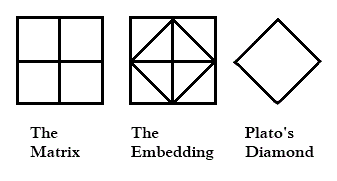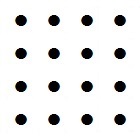


Judy Davis in the Marabar Caves
See also "Resplendent Triviality" in this journal.
https://theosophy.wiki/en/Jirah_Dewey_Buck —
" Dr. Jirah Dewey Buck (November 20, 1838 – December 13, 1916)
was a physician who worked to establish one of the first Theosophical
lodges in the United States, the Cincinnati Theosophical Society, and
the American Section of the international Theosophical Society in 1886 . . . ."
"Buck was born in Fredonia, New York
on November 20, 1838 . . . .
[He was] 'a recognized leader of a definite school
of Masonic thought and propaganda'."
The above metadata was suggested by an image I happened to see today,
the "Tetragrammaton of Pythagoras" —

"Duck Soup" fans may recall the war between Freedonia and Sylvania.
For some images more in the spirit of Sylvania, see "Triangles Are Square."
. . . .
"In Weber’s hands, the professor and the politician
are not figures to be joined. Each remains a lonely hero
of heavy burden, sent to ride against his particular foe:
the overly structured institution of the modern mind,
the overly structured institution of the modern state."
See also Chomsky in this journal.
From The New York Times on June 20, 2018 —
" In a widely read article published early this year on arXiv.org,
a site for scientific papers, Gary Marcus, a professor at
New York University, posed the question:
'Is deep learning approaching a wall?'
He wrote, 'As is so often the case, the patterns extracted
by deep learning are more superficial than they initially appear.' "
See as well an image from posts tagged Quantum Suffering . . .


The time above, 10:06:48 PM July 16, is when I saw …

"What you mean 'we,' Milbank?"
The elementary shapes at the top of the figure below mirror
the looking-glass property of the classical Lo Shu square.
The nine shapes at top left* and their looking-glass reflection
illustrate the looking-glass reflection relating two orthogonal
Latin squares over the three digits of modulo-three arithmetic.
Combining these two orthogonal Latin squares,** we have a
representation in base three of the numbers from 0 to 8.
Adding 1 to each of these numbers yields the Lo Shu square.

* The array at top left is from the cover of
Wonder Years:
Werkplaats Typografie 1998-2008.
** A well-known construction.
*** For other instances of what might be
called "design grammar" in combinatorics,
see a slide presentation by Robin Wilson.
No reference to the work of Chomsky is
intended.
Or: Philosophy for Jews
From a New Yorker weblog post dated Dec. 6, 2012 —
"Happy Birthday, Noam Chomsky" by Gary Marcus—
"… two titans facing off, with Chomsky, as ever,
defining the contest"
"Chomsky sees himself, correctly, as continuing
a conversation that goes back to Plato, especially
the Meno dialogue, in which a slave boy is
revealed by Socrates to know truths about
geometry that he hadn’t realized he knew."
Socrates and the slave boy discussed a rather elementary "truth
about geometry" — A diamond inscribed in a square has area 2
(and side the square root of 2) if the square itself has area 4
(and side 2).

Consider that not-particularly-deep structure from the Meno dialogue
in the light of the following…


The following analysis of the Meno diagram from yesterday's
post "The Embedding" contradicts the Lévi-Strauss dictum on
the impossibility of going beyond a simple binary opposition.
(The Chinese word taiji denotes the fundamental concept in
Chinese philosophy that such a going-beyond is both useful
and possible.)
The matrix at left below represents the feminine yin principle
and the diamond at right represents the masculine yang .

From a post of Sept. 22,
"Binary Opposition Illustrated" —

A symbol of the unity of yin and yang —
Related material:
A much more sophisticated approach to the "deep structure" of the
Meno diagram —

The previous post quoted Tom Wolfe on Chomsky's use of
the word "array."
An example of particular interest is the 4×4 array
(whether of dots or of unit squares) —

 .
.
Some context for the 4×4 array —
The following definition indicates that the 4×4 array, when
suitably coordinatized, underlies the Kummer lattice .

Further background on the Kummer lattice:
Alice Garbagnati and Alessandra Sarti,
"Kummer Surfaces and K3 surfaces
with $(Z/2Z)^4$ symplectic action."
To appear in Rocky Mountain J. Math. —
The above article is written from the viewpoint of traditional
algebraic geometry. For a less traditional view of the underlying
affine 4-space from finite geometry, see the website
Finite Geometry of the Square and Cube.
Some further context …
"To our knowledge, the relation of the Golay code
to the Kummer lattice … is a new observation."
— Anne Taormina and Katrin Wendland,
"The overarching finite symmetry group of
Kummer surfaces in the Mathieu group M24 "
As noted earlier, Taormina and Wendland seem not to be aware of
R. W. H. T. Hudson's use of the (uncoordinatized*) 4×4 array in his
1905 book Kummer's Quartic Surface. The array was coordinatized,
i.e. given a "vector space structure," by Cullinane eight years prior to
the cited remarks of Curtis.
* Update of Sept. 14: "Uncoordinatized," but parametrized by 0 and
the 15 two-subsets of a six-set. See the post of Sept. 13.
Syntactic Structure —
See the Lightfoot of today's previous post:

Symplectic Structure —
See the plaited, or woven, structure of August 6:
 .
.
See also Deep Structure (Dec. 9, 2012).
The concept of "deep structure," once a popular meme,
has long been abandoned by Chomskians.
It still applies, however, to the 1976 mathematics, diamond theory ,
underlying the formal patterns discussed in a Royal Society paper
this year.
A review of deep structure, from the Wikipedia article Cartesian linguistics—
|
[Numbers in parentheses refer to pages in the original 1966 Harper edition of Chomsky's book Cartesian Linguistics .] Deep structure vs. surface structure "Pursuing the fundamental distinction between body and mind, Cartesian linguistics characteristically assumes that language has two aspects" (32). These are namely the sound/character of a linguistic sign and its significance (32). Semantic interpretation or phonetic interpretation may not be identical in Cartesian linguistics (32). Deep structures are often only represented in the mind (a mirror of thought), as opposed to surface structures, which are not. Deep structures vary less between languages than surface structures. For instance, the transformational operations to derive surface forms of Latin and French may obscure common features of their deep structures (39). Chomsky proposes, "In many respects, it seems to me quite accurate, then, to regard the theory of transformational generative grammar, as it is developing in current work, as essentially a modern and more explicit version of the Port-Royal theory" (39). Summary of Port Royal Grammar The Port Royal Grammar is an often cited reference in Cartesian Linguistics and is considered by Chomsky to be a more than suitable example of Cartesian linguistic philosophy. "A sentence has an inner mental aspect (a deep structure that conveys its meaning) and an outer, physical aspect as a sound sequence"***** This theory of deep and surface structures, developed in Port Royal linguistics, meets the formal requirements of language theory. Chomsky describes it in modern terms as "a base system that generates deep structures and a transformational system that maps these into surface structures", essentially a form of transformational grammar akin to modern studies (42). |
The corresponding concepts from diamond theory are…
"Deep structure"— The line diagrams indicating the underlying
structure of varying patterns
"A base system that generates deep structures"—
Group actions on square arrays… for instance, on the 4×4 square
"A transformational system"— The decomposition theorem
that maps deep structure into surface structure (and vice-versa)
Orwell's question, according to
an admirer of leftist Noam Chomsky:
"When so much of the BS is right out in the open,
why is it that we know so little about it?
Why don't we see what's right in front of our eyes?"
 Oscar |
Deep Chomsky: Lying, Truth-Telling, and the Social Order
|
 Michael Moore |
"First of all, I'd like to thank the Academy…."
— Quotation attributed to Plato
The New Yorker of March 31, 2003, discusses leftist academic Noam Chomsky. The online edition provides a web page listing pro-Chomsky links.
Chomsky's influence is based in part on the popularity of his half-baked theories on linguistics, starting in the 1950's with "deep structure" and "transformational," or "generative," grammar.
Chomsky has abandoned many of his previous ideas and currently touts what he calls The Minimalist Program.
For some background on Chomsky's recent linguistic notions, see the expository essay "Syntactic Theory," by Elly van Gelderen of the Arizona State University English Department. Van Gelderen lists her leftist political agenda on her "Other Interests" page. Her department may serve as an example of how leftists have converted many English departments in American universities to propaganda factories.
Some attacks on Chomsky's scholarship:
Forty-four Reasons Why the Chomskians Are Mistaken
Chomsky's (Mis)Understanding of Human Thinking
Anatomy of a Revolution… Chomsky in 1962
…Linguistic Theory: The Rationality of Noam Chomsky
Some attacks on Chomsky's propaganda:
Destructive Generation excerpt
Partners in Hate: Noam Chomsky and the Holocaust Deniers
Chomsky and Plato's Diamond

Like another purveyor of leftist nonsense, Jacques Derrida, Chomsky is fond of citing Plato as a precedent. In particular, what Chomsky calls "Plato's problem" is discussed in Plato's Meno. For a look at the diamond figure that plays a central role in that dialogue, see Diamond Theory. For an excellent overview of related material in Plato, see Theory of Forms.
Powered by WordPress